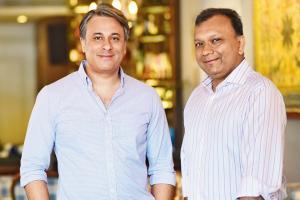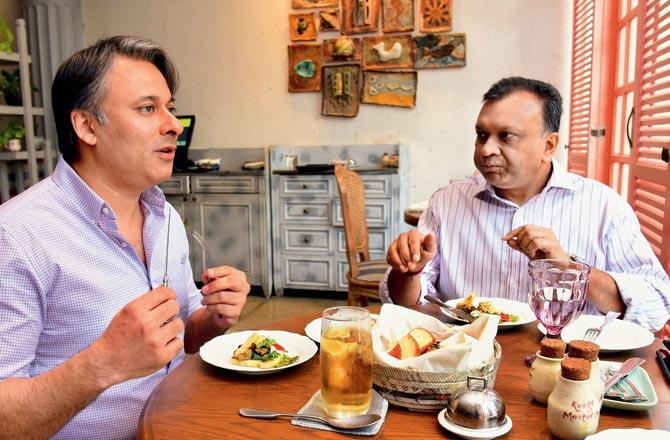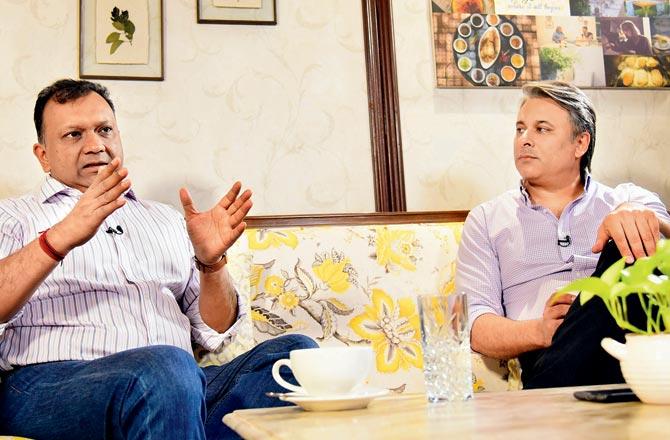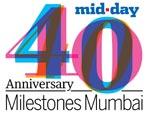The man who brought fast food to Mumbai, and the guy who made fast delivery successful, Amit Jatia and Rishi Khiani discuss the success of McDonald's and Scootsy, while dissing the theory that the city,s F&B scene is saturated.

Rishi Khiani and Amit Jatia Pics/ Shadab Khan
Rishi Khiani has given Amit Jatia business. Not as a food entrepreneur, but customer. As a young man in his 20s, he queued up outside the Linking Road outlet of McDonald's for a portion of McNuggets. Jatia, 52, vice-chairperson of Westlife Development Ltd, operates a chain of McDonald's outlets in west and south India through its wholly owned subsidiary Hardcastle Restaurants Pvt Ltd. As early as 1996, he offered customers an alternative to pav bhaji and pani puri. French fries and burgers were available to them for as cheap as R20. Over the years, the QSR's Golden Arches (89 outlets in Mumbai) have not only adapted to the city's changing foodscape but also pioneered a few shifts, like introducing the McAloo Tikki burger customised to placate the Indian palate.

Some 15 years after Jatia saw success, Khiani, 44, revolutionised the manner in which food arrived to you by launching the intra-city delivery platform Scootsy. By offering to drop off at your door step not only eatables but also electroncs and books within 60 minutes, the start-up changed Mumbai's ordering pattern. The CEO and MD of Antfarm Business Incubator Pvt Ltd, Khiani is a seasoned entrepreneur with over 20 years of experience in media, consumer tech and enterprise. Last year, he moved from Scootsy after it was acquired by Swiggy to focus on his other ventures, ad-tech firm Fork Media and health food brand Hello Green. Over brunch where they tuck into Provençale-style tartine, taka-luchi alur dom and maachher paturi at Worli's French-Bengali restaurant Mustard, the entrepreneurs share notes on being market disruptors.

mid-day: Rishi, you were among those who lined up outside McDonald's when it opened, we hear.
Rishi: Of course. I would head to the one in Bandra and later, to the CST outlet. It was a family thing, actually. The idea was that the whole family could sit together and enjoy a meal. And everyone at home had their favourites. As a kid, when I'd go to London, I would wait to visit McDonald's and tuck into the chicken McNuggets and filet-o-fish. The flavours were etched in my memory. McDonald's would create a false scarcity around its menu. We'd wait for phone alerts about the McRib burger being available. There would be a queue outside the outlets and it would always be sold out.
Amit: I remember that (laughs).
mid-day: What do you both remember about the eating out scene from the '90s?
Amit: The only QSR-type of restaurant I remember was Open House in Bandra. As young boys living in south Mumbai, we'd rush to try the food there.
Rishi: Me too. Their pizzas and burgers were favourites. Under The Over at Altamount Road was another haunt. Or then, we'd head to an udupi. Amit: I grew up eating at Samarkand at the Oberoi, Tanjore at Taj, and at Copper Chimney. The options were limited. And, the frequency of eating out was low.

mid-day: Then, what changed?
Amit: Malls and multiplexes became catalysts for a change. People began to step out more often and once they did, they'd head to a restaurant. Previously, we would eat out only on weekends. But it's [the frequency] still lower than cities like Jakarta and Bangkok, where people eat out roughly 20-plus and 44 times a month respectively.
Rishi: At Scootsy, we used to track eating out trends. Customers ordered healthy food on Mondays and Tuesdays because they had to work through the week. By the weekend, they indulged in massive meals. Diners are also more open to experimenting, and a show like MasterChef Australia is responsible. Who would have thought we'd have an Ethiopian cuisine restaurant in Mumbai?
mid-day: How important is 'going local' for an F&B entrepreneur?
Amit: Flavours change every few kilometres. And if you don't adapt, your brand won't work. Globally, McDonald's had never really been into menu developmen. But we learnt quickly that we would have to cater to local taste. That's why, we launched the McAloo Tikki burger. But localisation alone doesn't work either. It needs to be relevant to what is being offered. A McDonald's can't beat Sukh Sagar at its dosa but it can turn the masala dosa into a burger. So, it's glocalisation that's important.
Rishi: In case of Scootsy, the meaning of local was an intra-city approach, operating within a radius of 10km. We wanted to get you food from your favourite restaurant in Worli to your home in Colaba. And suddenly, options exploded. Customising is equally important for players today. With technology, you can learn about a customer's food preferences from past consumption patterns. That helps you target your communication to the individuals accordingly. In my home, for example, six members like six different cuisines. We'd have fights over what to order. With a delivery app, we are exercising an individual choice. Everyone can place their own order.

mid-day: And how did ordering in become huge?
Rishi: Back in the 1990s and early 2000s, newspapers would carry pamphlets about neighbourhood eateries where you could order from. These were hyperlocal deliveries within a radius of 3km. So, there was always a demand for delivery food. However, all restaurant kitchens weren't prepared for sending out orders. A restaurant was meant to offer a great experience to a walk-in diner. Today, restaurants too are thinking about delivery as a business model. Systems are being put into place to clear bottlenecks in the kitchen and improve both the dine-in and delivery experience.
Amit: The delivery model is based on convenience. I remember McDonald's launched deliveries in 2005 but it took off only in 2013, after we launched the app and web platform. The business growth rose to almost 50 per cent.
Rishi: Yes. When you thought of getting food in a hurry, it would always be from Domino's because the delivery was consistent. You knew you'd get it within 30 minutes. The same happened when McDelivery was launched. They were the pioneers. And the packaging was consistent too. The shift from dining out to ordering in has been more visible in the last five years because the options of restaurants available on the apps has increased. In fact, delivery apps are also helping new brands who may not want to bear the cost of brick-and-mortar spaces but only sample the market. So, they set up cloud kitchens. This also helps them push the envelope in terms of reduced prices and innovative menus. And, deliveries are not cannibalising the market. It's not one versus the other. The consumer is king and spoilt for choice.

mid-day: Has the concept of cloud kitchens really caught on in Mumbai? There is divided opinion.
Amit: The jury is still out on that one. I believe it's still only a concept. While a cloud kitchen saves on retail cost, one has to pay an aggregator. That takes away more than what was saved.
Rishi: Also, the credibility of a brand is still associated with a physical location. But formats are changing. I see more F&B brands looking at smaller physical spaces but larger footprint. That's why, there are shop-in-shop establishments in complexes like Indiabulls or WeWork.
mid-day: What challenges are unique to Mumbai for an entrepreneur with an innovative concept in the service sector?
Amit: Real estate. And not just in terms of money. It's tough to find a space that's 3,000 sq ft in size. Then, you have to get the approvals and licensces. Some land is also owned by the state government and the Bombay Port Trust. Add to that, the actual cost of the land. So, it's a challenge to grow a brand quickly in Mumbai. Having said that, I'm encouraged by some of the quick decisions being allowed under the present Chief Minister. The customer is also more price sensitive than say, a Delhiite. Even a rupee change impacts preferences. But my philosophy is that the city is a huge market. So, instead of venturing into smaller cities and opening single outlets there, we should own the market in Mumbai.
Rishi: But, Mumbai is not an easy market. You can deliver on time 99 times but the one time you don't, people will take to social media and rant about never ordering from the brand again. These evangelists and ambassadors can become your biggest detractors. That keeps you on your toes. Twitter and social media has made us more responsible.

Illustration/ Ravi Jadhav
Will a 24x7 nightlife policy be effective here?
Rishi: There is a definite demand for late-night deliveries. We'd get a lot of orders. But if you have dining and entertainment hubs open 24x7, they also need to be policed in the right way.
Amit: Many McDonald's outlets globally are open 24x7 and they work well. If you want to put Mumbai on the global map as an F&B destination, you'll have to go 24/7 eventually.
Catch up on all the latest entertainment news and gossip here. Also download the new mid-day Android and iOS apps to get latest updates
 Subscribe today by clicking the link and stay updated with the latest news!" Click here!
Subscribe today by clicking the link and stay updated with the latest news!" Click here!










